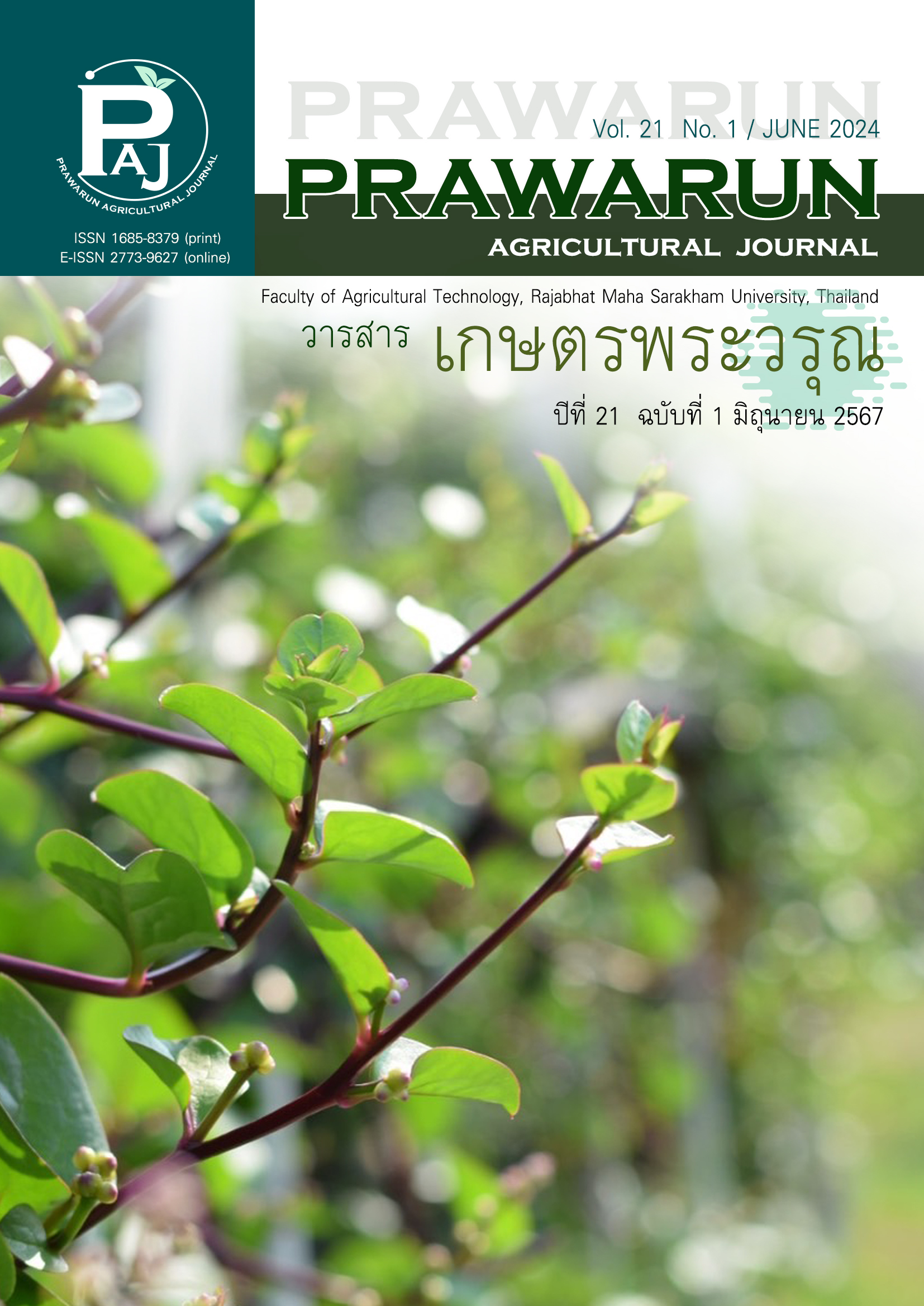Effects of using fibro-biotics from water hyacinth in diet on growth performance, nutrient digestibility and microbial population in posterior gut of post-weaning pigs
Main Article Content
Abstract
Fibro-biotics, derived from water hyacinth, are modified with cellulose producing microbes, resulting in higher protein and lower fiber content and can be used in pig feed. The objective of this study was to investigate the effects of using fibro-biotics from water hyacinth in diets on growth performance, nutrient digestibility and microbial population in posterior gut in post-weaning pigs. Twenty four males of Large-White x Landrace crossbred pigs (average body weight 10.2±3.41 kg) were arranged in completely randomized design. The experiment consisted of four treatments, each with three replications; treatment 1 was a controlled diet (0 % of water hyacinth fibro-biotics) treatment 2, 3, and 4 were contained 5, 10, and 15 % of water hyacinth fibro-biotics, respectively. Within 60 days of experimental duration the results showed, feed intake and digestibility of dry matter and protein were decreased at 15 % (P < 0.01) while at 5 and 10 % were not significant different when compared with a control (P > 0.05). Body weight gain and ADG increased at the level of 5 % (P = 0.07) but decreased at the level of 15 % (P < 0.01). As a result, FCR was the lowest at the 5 % level (P < 0.05) but increased at the level of 15 % (P < 0.01). Feed costs per gain were not significant different (P > 0.05). However, there was an average reduction of 0.9-1.4 baht/kg of weight gain when using fibro-biotic from water hyacinth 5-15 %. Fibro-biotics from water hyacinth resulted in a higher number of lactic acid bacteria in the intestinal tract (P < 0.01), while there was no difference in the number of E. coli and total microorganisms (P > 0.05). It has been shown that fibro-biotics from water hyacinth can be used in post-weaning pig diets. A 5 % inclusion level is likely the most appropriate and has a positive effect on growth performance
Article Details
References
Association of Official Analytical Chemists (AOAC). (1995). Official method of analysis (16th ed.). Washington D.C, United States: Association of Official Analytical Chemist.
Association of Official Analytical Chemists (AOAC). (2000). Official methods of analysis (17th ed.). Arlington, Virginia, United States: Association of Official Analytical Chemists.
Bai, K., Huang, Q. Zhang, J., He, J., Zhang, J., & Wang, T. (2017). Supplemental effects of probiotic Bacillus subtilis fmbJ on growth performance, antioxidant capacity, and meat quality of broilers chickens. Poultry Science, 96(1), 74–82. doi:10.3382/ps/pew246
Bureenok, S., Tamaki, M., Kawamoto, Y., & Nakada, T. (2007). Additive effects of green tea on fermented juice of the epiphytic lactic acid bacteria (FJLB) and the fermentative quality of Rhodesgrass silage. Asian-Australasian Journal of Animal Sciences, 20(6), 920-924. doi:10.5713/ajas.2007.920
Giannenas, I., Tontis, D., Tsalie, E., Chronis, E. F., Doukas, D., & Kyriazakis, I. (2010). Influence of dietary mushroom Agaricus bisporus on intestinal morphology and microflora composition in broilers chickens. Research in Veterinary Science, 89(1), 78-84. doi: 10.1016/j.rvsc.2010.02.003
Kuprys-Caruk, M., Chabłowska, B., Michalczuk, M., & Stefanska, I. (2019). Comparison of the effect of lactic acid bacteria added to feed or water on growth performance, health status and gut microbiota of chickens broilers. Annals of Warsaw University of Life Sciences – SGGW Animal Science, 58(1), 55–67. doi:10.22630/AAS.2019.58.1.7
Makivic, L., Glisic, M., Boskovic, M., Djordjevic, J., Markovic, R., Baltic, M., & Sefer, D. (2019). Performances, ileal and cecal microbial populations and histological characteristics in broilers fed diets supplemented with lignocellulose. Kafkas Universitesi Veteriner Fakultesi Dergisi, 25(1), 83-91. doi:10.9775/kvfd.2018.20356
Mako, A. A., Banjo, O. S., & Akinwande, V. O. (2012). Nutritive evaluation and acceptability of two aquatic weeds (Eichhornia crassipes and Acroceras zizanioides) by West African dwarf goats. African Journal of Agricultural Research, 7(19), 3007-3013. doi: 10.5897/AJAR11.1379
Mountzouris, K. C., Tsirsikos, P., Palamidi, I., Arvanniti, A., Mohnl, M., Schatmayr, G., & Fegeros, K. (2010). Effect of probiotic inclusion levels in broilers nutrition on growth performance, nutrient digestibility, plasma immunoglobulin, and cecal microflora composition. Poultry Science, 89(1), 58-67. doi: 10.3382/ps.2009-00308
Raunghora, N., Chaiwong, S., Jintanuworakul, K., Chaiyasaen, N., Sintala, K., Bourapa, R., & Srakaew, W. (2024). Supplementation of natural symbiotic from cocoa husk silage on production performance and egg quality in laying hen. Proceedings of the 4th The virtual international conference on science and agricultural technology for students 2024 (VICSAT 2024) (p. 11). Chiang Mai, Thailand: Rajamangala University of Technology Lanna. (in Thai)
Sharifi, S. D., Dibamehr, A., Lotfollahian, H., & Baurhoo, B. (2012). Effects of flavomycin and probiotic supplementation to diets containing different sources of fat on growth performance, intestinal morphology, apparent metabolizable energy, and fat digestibility in broiler chickens. Poultry Science, 91(4), 918-927. doi: 10.3382/ps.2011-01844
Statistical Analysis System (SAS). (1998). User's guide: Statistic, version 6 (12th ed). Cary North Carolina, United States: SAS Institute Inc.
Tongnum, A., Srakaew, W., & Insoongnern, H. (2024). Effect of using bio-feed ingredient from water hyacinth (Eichhornia crassipes Mart) to optimize rumen fermentation in vitro gas technique. Proceedings of the 4th The virtual international conference on science and agricultural technology for students 2024 (VICSAT 2024) (p. 12). Chiang Mai, Thailand: Rajamangala University of Technology Lanna. (in Thai)
Wenk, C. (2001). The role of dietary fibre in the digestive physiology of the pig. Animal Feed Science and Technology, 90(1-2), 21-33. doi:10.1016/S0377-8401(01)00194-8
Zhou, X., Wang, Y., Gu, Q., & Li, W. (2010). Effect of dietary probiotic, Bacillus coagulans, on growth performance, chemical composition, and meat quality of Guangxi yellow chicken. Poultry Science, 89(3), 588-593. doi: 10.3382/ps.2009-00319


